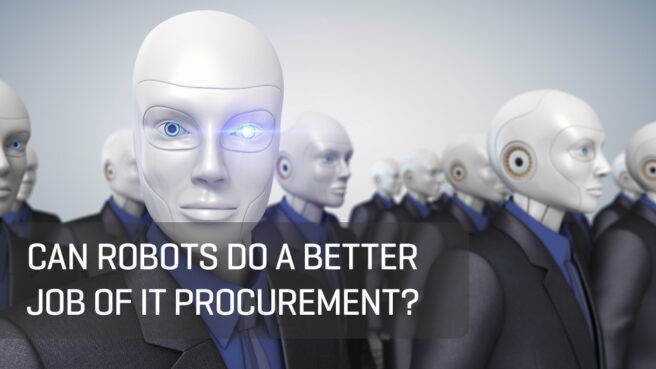The IT procurement robots are coming, how can we ensure they get it right?

It’s a well-worn movie cliché: the out-of-control robot providing comic relief. Whether it’s accelerating a production line conveyor belt to warp speed, talking nonsense or chasing its tail in circles, we all enjoy a laugh at our short-circuited automated friends.
But assuming the root cause of the problem is programming could be a mistake. What if the programming is working perfectly, but it’s the inputs that are erroneous?
The statement from Gartner below got me thinking recently.
At Snow, we’re big fans of automation. We strongly believe that the right kinds of automation – whether simple otherwise-laborious tasks, or more complex workflows – are a good thing for organizations that want to run smooth and streamlined operations.
The idea of “things” initiating IT procurement makes a lot of sense. After all, we’ve already seen it in the consumer world: fridges that can re-order fresh milk when they sense you’re running low, or cars that can book themselves in for services when an oil change is due. If it makes my life easier (and I get more time to spend cycling in the sun), I’m all for it!
But what happens when I get four pints of milk delivered to my door every day for two weeks solid? Or my car books itself in for a service every 12 weeks instead of 12 months? Suddenly automation is costing me time and money, not saving it.
My initial response would be to blame the programming. But what if the programming was working perfectly well? What could be causing the issue?
In the examples above, the root cause could likely be a faulty sensor rather than poorly-written programing or workflows.
When a sensor sends the wrong information to the main application (in this case perhaps it’s that a pressure sensor in the milk holder in the fridge is saying the milk carton is nearly empty because it is reading the weight wrong, or the car’s automated dipstick is reading empty when it’s perfectly fine), it is hardly surprising that we get the wrong result.
So how does this apply to Snow and the process of optimizing software consumption across the organization? Are we opening a sideline in cheap fresh milk?
Thankfully no, we’ll leave producing milk to the experts, the farmers.
And stick to what we’re expert in: providing accurate information about what’s happening on the network and how software and subscriptions are being consumed.
Returning to Gartner’s statement, I believe the biggest risk in the automation of IT procurement is providing the automation process with the right inputs. In our world, that means an accurate view of what software is installed or what subscriptions an individual user has access to. Call it Discovery and Inventory, if you will.
It also means knowing whether that user is actually using the assets that they are currently entitled to. And if they are not, having the means to recover the license or subscription so that it can be re-distributed (sometimes referred to as harvesting) to other users, rather than initiating a new procurement process. Or perhaps the individual is not using the full capabilities of the solution or subscription and can be migrated to a cheaper option.
And finally, you need to know how what you’re already using across the organization relates to what you’re currently allowed to use. That means inputs in terms of software licenses and agreements, as well as a reconciliation between these and consumption.
When it comes to automating IT procurement, it will only work when the right inputs are in place. Given that Gartner believes that most organizations around the world already overspend on software licensing by around 30% each year, it’s difficult to see how automation will not compound this issue without the right inputs.
On the other hand, when those right inputs are in place, the results of automation can be compelling. I’ve seen Snow customers reduce their exposure on SAP licensing by as much as $25 million or reduce their Microsoft spend by $4 million per year. Imagine having someone constantly optimizing your software procurement and licensing 24/7. No rest. And no coffee!
In defense of the SAM & licensing professional
That’s not to say that Software Asset Management professionals are a dying breed or an endangered species. Far from it. Dare I say it, the savings highlighted above are the low-hanging fruit; the savings that an advanced SAM platform like Snow can deliver with ease.
But there are judgement calls that cannot yet – and perhaps never will – be automated. The intricacies of software licensing are complex and subtle. And neither Snow, nor any other SAM solutions vendor, has yet worked out how to completely replace the trained mk1 human brain (no matter what they might claim).
Managing the disruption gap caused by IT spend being fragmented across the wider organization is perhaps an excellent showcase for automation in the here and now. With the right inputs in place, certain tasks like harvesting licenses, controlling the spinning-up (and down) of virtual cloud assets and even moving users from one subscription package to another can be automated with confidence.
And this buys the IT leaders and SAM professionals the time they need to focus on the stuff the ‘robots’ can’t do. The judgement calls that only an experienced human mind can take. And the contract negotiations where automation can’t beat the thrill of cutting a great deal face-to-face.
The robots are coming. And perhaps they might be useful…
Want to discover the benefits of automating your SAM processes? Why not take a Snow test drive today?